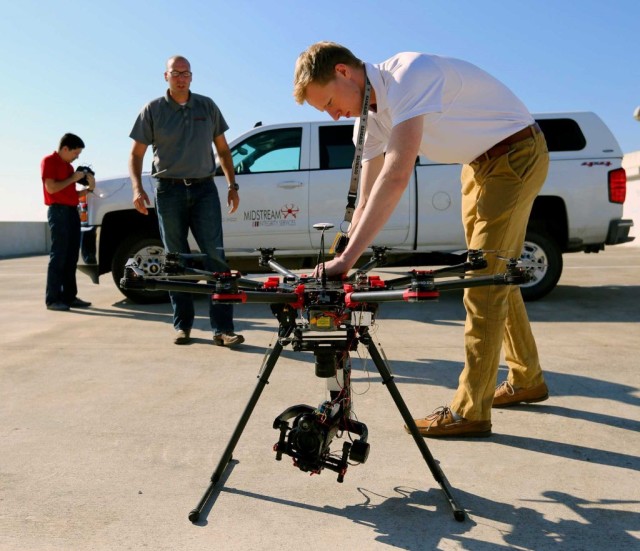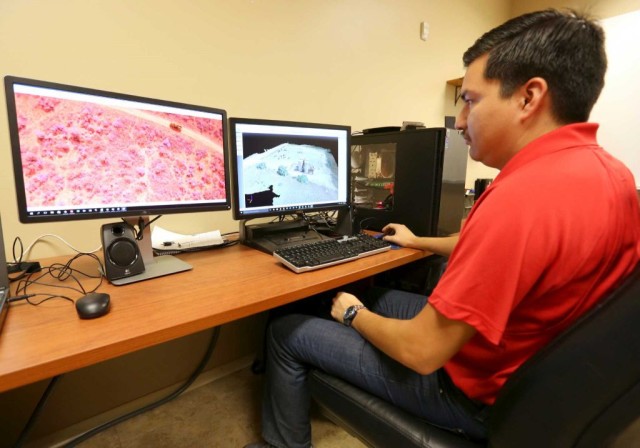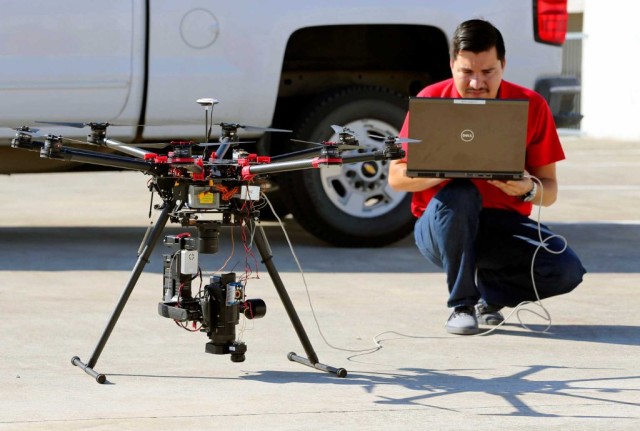 At a South Texas ranch, a drone mounted with cameras flew above and around a flare stack that burned natural gas. Live, high-definition images were transmitted back to the ground, where company officials watched video of the flare stack as it was operating, asking that the drone move this way or that to get a better image or different angle.
At a South Texas ranch, a drone mounted with cameras flew above and around a flare stack that burned natural gas. Live, high-definition images were transmitted back to the ground, where company officials watched video of the flare stack as it was operating, asking that the drone move this way or that to get a better image or different angle.
It’s a scene that played out recently, and it may become more common. Though drones are in their commercial infancy, their use in the oil field is on the increase.
In the case of the South Texas flare stack, a drone from San Antonio-based Midstream Integrity Services helped a client check its flare stack while avoiding a shutdown of equipment. “They could see what they needed to order to replace in the future,” said Landon Phillips, program manager for unmanned aerial systems (UAS) at Midstream Integrity Services. “The image is very stable, and we can look straight down into equipment while it’s operating.”
Jerry Hendrix, executive director of the Lone Star Unmanned Aircraft Systems Center of Excellence & Innovation at Texas A&M University-Corpus Christi, said that Texas is a natural fit for drone use and research, and it’s not just the oil industry looking at how to use drones. Hundreds of companies and industries are looking into drones for inspection and monitoring of things such as railroad tracks, bridges, wind turbines, utility lines or agricultural fields. Drones can monitor red tide on the coastline, or might be used by first responders after a natural disaster such as a hurricane.
“There’s the potential for the use of UAS to spot oil spills and things of that nature,” Hendrix said. “There’s a lot of tremendous applications of UAS.”
For the oil and gas industry, Joe Henry of Camber Corp., which works with A&M-Corpus Christi’s UAS center, said the facilities best suited for drone use — with obvious cost and safety benefits — are industrial plants. Some facilities shut down as many as 26 times per year for inspections, he said, each time building and then tearing down scaffolding at great expense.
“Just imagine reducing the cost of raising scaffolding and tearing down scaffolding and having to shut the plant down for those inspections,” Henry said.
The idea of inspecting and monitoring with drones is new, though Henry noted that companies will look at drones as a way to save money. “None of this is defined yet,” Henry said. “You can look at the cost of oil. They’re looking at how to reduce cost and let money flow into the bottom line.”
For now, drones are not allowed to operate beyond the line of sight, about 1 mile usually, Phillips said, and their use requires a pilot and a visual observer.
Midstream Integrity’s drones can shoot video that will send a live feed back to the ground. Point-and-shoot cameras can be used to stitch images together afterward to measure things such as distance and structures, or dying vegetation that can indicate a problem with a pipeline or piece of equipment. An infrared image can show things such as the health of plants, through the level of chlorophyl in them. Laser methane detectors, which measure reflected energy, can tell how much methane is in the air. Phillips said that it could be possible to take air samples while flying.
The company’s leadership includes Phillips and Steven Fargo, childhood friends who became Air Force pilots — Phillips flying the A-10 Warthog and Fargo flying the F-16. Now, Phillips serves in the Air Force Reserves and Fargo serves in the Texas Air National Guard.
For an experienced pilot with thousands of flight hours, learning to fly a drone is fairly straightforward, Phillips said. What’s important for the company is that drone pilots have an understanding of aviation culture. “We have guys that understand air space. You have to know how to speak FAA,” Phillips said. “It’s understanding how to operate in the national air space system.”
The company also has to navigate the oil and gas industry, which has its own culture and safety concerns. Midstream Integrity’s industry partners are BlackBrush Oil & Gas LP and Flat Rock Engineering and Environmental LP, both based in San Antonio. Midstream Integrity also has a research agreement with the University of Texas at San Antonio.
Hendrix said the Lone Star Unmanned Aircraft Systems Center is developing a credentialing program, which could be available early next year, as a way to reassure oil and gas companies that drone operators understand their safety concerns and the high value of the equipment in the field. They also need to understand aviation regulations, and be competent at flying the drones.
“What we’re finding out in the oil and gas sector is they’re extremely safety conscious. They need to protect their intellectual property,” Hendrix said. “This would be an enabler for the industry to grow.”
Photos: William Luther / San Antonio Express-News
Source: San Antonio Express-News


